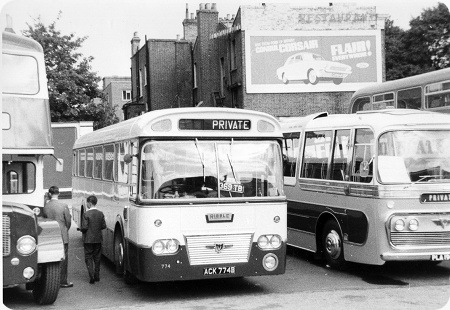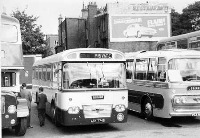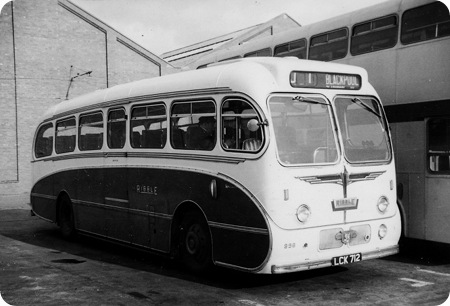
Ribble Motor Services
1964
Leyland Panther PSUR1/2RT
Marshall DP49F
Odd man out in the Ribble fleet for over ten years was the first production Leyland Panther, which I
photographed outside the September 1964 Earls Court Commercial Motor Show.
It is possible that it
entered Ribble service for a spell before the show, and early on in its career it ran on the Blackpool
to London service, presumably on hire to Standerwick. It operated from Preston garage for most of its
life. Withdrawn from service in 9/75, no further owners are known to me.
Photographs of it
actually in service are few and far between, the few I have seen are usually on private hire work.
Any recollections or in service photos would be of great interest!
It seems that Panther
coaches were not too common.
From ‘Bus Lists On The Web’ and Doug Jack’s
‘Leyland’ book, I see that there were some other PSUR1/2 coaches for the home market, as follows:
15 for East Yorkshire in 1966, with Marshall bus bodies! B49F (why use a coach chassis you may ask!)
2 for East Yorkshire with Metro Cammell C44F bodies in 6/67
4 for East Yorkshire in 1/68
with Marshall DP49F bodies
5 for East Yorkshire in 1968 with Plaxton C44F bodies
1 for
Soudley Valley Coaches, Glos in 11/66 with Plaxton C51F body
10 for Seamarks of Westoning, Beds
with O.680 engines and Plaxton C51F bodies in 1968 (full air change ?)
6 for Seamarks with Plaxton
C51F bodies in 1969
4 for Skills of Nottingham, two in 1969 and two PSUR1B/2R in
1971 all
with Plaxton C51F bodies
Photos of any of these would be of interest.
Many more were exported, which was also the case
with the bus version, which did well in Australia.
Photograph and Copy contributed by Peter G Greaves
This unique Panther was the reason that Ribble continued to buy large numbers
of Leopards (bus, DP and coach versions) and ultimately why they became a major RE user. It was a
disaster. Unreliable, it probably slept in the corner of Frenchwood for much of its life and was
condemned to private hire to avoid the (bad) publicity of breakdown on high profile long distance
express services. The sad fact was that the Leopard was reliable, the Panther not.
Some,
including Preston Corporation and the Aussies, persisted with the Panther and seemed to make it work
but most British operators - including Manchester - had similar experience. It put back the case for
low(er) floor vehicles for some years - and certainly until the RE was made available on the open
market later in the decade.
[I think that you will also find that Maidstone and District had
similar numbers and types of Panther as East Yorkshire.]
This must also have been a fairly
early Marshall body for both Ribble and BET - who became a major, and repeat, customer of this well
built body. [Even stars have Achilles heels though and I gather in grand old age - ie in
preservation - some Marshalls need quite a bit of tlc, otherwise their front platform can fall off!]
The East Yorkshire Met-Camms were full coaches of the Topaz design - although I seem to
remember that that was the "Bedford" designation and that Leylands had a different name.
After closure of Weymann at Addlestone, Metro-Cammell took on the mantle of coaches from the line of
the Fanfare and Castillians. They were true coaches but they never realised a balanced design that
pleased either generally or, indeed, as a coach.
David Oldfield
All the early rear-engined single deckers - Roadliner, Panther, Panther Cub
and Swift/Merlin - were pretty disastrous, apart from the Bristol RE, which possibly benefited from
having the radiator at the front and the engine mounted slightly further forward than the others.
As you say, some operators persevered, and Sunderland reckoned that by the time they got it
right the Panther was a really good vehicle. Their experience included a comparison of bodies
between MCW’s, which was attached to the chassis throughout, and a much more successful effort by
Strachan which featured a separate cantilevered subframe supporting the rear end of the body,
allowing the chassis to go its own way.
According to Stewart J Brown’s "Luxury
Travel" book, the East Yorkshire MCW coaches were designated Topaz II.
Peter Williamson
03/09/11 - 05:41
This machine was used in the late 60s and early 70s at various times in
addition to Private Hire on Stage Carriage and on two or three times to my knowledge on the X30
Preston to Glasgow, X11 Preston Edinburgh and the X20 Preston to Glasgow Night Service Express. As
these services operated as a duplicate to the peak season service from Manchester and Liverpool any
coach or DP could be used from Preston.
Brian Cowdall
04/09/11 - 07:54
I always disliked this type of incongruous sharp cornered radiator grille on
otherwise handsome bodies. They gave the impression of having been assembled "in house"
from spare material after possible accident repairs and never looked right to me.
Chris Youhill
12/01/14 - 09:15
I travelled on a Ribble bus tour in 1963 from London to Nairne and back to
London. I still have the original ticket and bus itinerary. I also have a photo of the bus and the
driver. I was 18 years old and as I was the youngest on the tour I was nominated to get married at
Gretna Green to the bus driver. (who was married with children). They are happy memories.
Pam
12/01/14 - 11:10
Coach tours can be friendly like that, Pam, even today!
I re-read these
posts, David O, and you made mention of the closure of Weymanns at Addlestone, just down the road
from you. I wondered if there was the slightest trace left of their factory, or even the name
applied to a business park, a plaque in the pavement, or……anything?
Chris Hebbron
12/01/14 - 17:11
Pam
Would there be any chance of having a copy of the picture you have
of the Driver and Coach for my website.
This is at http://www.psvbadges.org.uk
I have a page for Driver and
Conductor pictures.
Thanks very much
Stephen Howarth
13/01/14 - 08:33
Chris. Sadly the answer is no, no, no and no. It is "covered" by
speculative offices and the name Aviation Park - reflecting its use BEFORE Weymanns.
David Oldfield
14/01/14 - 08:13
I’ve just noticed the advertisement for the Ford Corsair - if people hadn’t
taken photographs of buses how much of this incidental history would have been lost? Anyway, this
has reminded me of something that bothered me a few years ago: the Corsair was presumably around at
the same time as the Cortina MkI, but the Cortina lived on and the Corsair didn’t - can anybody
slightly longer in the tooth than myself tell me whether the Corsair was positioned above or below
the Cortina.
Anyway, back to the bus. Were all the problems with the chassis? or might some
have been down to the bodybuilders failing to account for the stresses caused by the flexing of all
that weight at the rear - Strachans’ bodies were cantilevered I think, allowing the rear-end to
flex, and didn’t suffer the problems that led, I believe, to a batch of Willowbrook(?)-bodied
single-deck Fleetlines in the Northern fleet almost cracking open. As the RE’s engine was situated
further forward than on other types then that would have reduced the stresses on the bodywork.
Philip Rushworth
14/01/14 - 09:44
Re the Corsair, the first thing to understand is the Ford line up in the UK in
the mid 1960s. The bottom of the range was the Anglia, next came the Cortina, then the Corsair,
after which the Zephyr and Zodiac topped off the range. Each type had a range of factory options so
each model was in effect a range within a range.
The Ford Consul had been produced until 1962
as the bottom tier of the Consul/Zephyr/Zodiac range. Ford then used the Consul name in a different
way producing the Consul Classic 4 door and the Consul Capri two door until the end of 1963. The
types were not to the public’s taste and disappeared at the end of 1963. The bottom tier of the
Consul range became the Consul Cortina, generally known as the Cortina Mk1.
The Corsair first
appeared at the 1963 Motor Show as the Consul Corsair as a replacement for the Consul Classic and
went on sale in 1964. It was positioned above the Cortina and was offered in various versions.
Originally powered by 1500cc Kent series in line engines, in 1965 the engine was replaced by a V-4
1600cc unit which contributed to the cars deteriorating sales from then on as it was noisy, rough
and not as responsive as the 1600E Cortina Mk 2 which took many Corsair customers. Ford had
introduced a 2000cc engine for the Corsair but its price point only worked in favour of the 1600E.
The company also produced a Corsair 2000E aimed at competing, with of all things, the current Rover
range but the cache off the Rover name meant more than price to most customers at that level.
When I worked for United Biscuits in 1967 we reps had Cortina 1300s and the area managers had
1600cc powered Corsairs.
In 1970 Ford re-jigged its range. The Escort, which had appeared in
1968, replaced the Anglia and also appealed to 1300cc basic Cortina Mk2 buyers so the Mk3 Cortina
was a bigger car than the Mk2 and replaced the more expensive Mk2s and the Corsair. By 1972 the
Zodiac/Zephyr had gone and were replaced by the Granada. With 310,000 Corsairs sold and a demand for
a larger than Cortina but cheaper than Granada model appearing, Ford reintroduced the Consul name
using the Granada body with a V-4 1996c engine and a V-6 giving 2495 cc. I had one of the former
which was as horrible as the V-4 Corsair but I later had 2000cc Pinto engined Consul produced from
1974 and that was some car.
Phil Blinkhorn
14/01/14 - 10:09
Phil, there’s a lot of anecdotal evidence about bodywork on the first
generation rear engined single deckers of the 1960’s, but I’ve never seen any formal article
produced about the subject. I’m sure many of us can trace articles or even books which cover the
faults and failings (and good points?) of Leyland Panthers, AEC Swifts, Daimler Roadliners, and
Seddon Pennine RUs. (I’m omitting the very first of all - the Bristol RE - both Bristol and ECW got
that right!). But I have yet to discover anything formal about the merits of the bodybuilders, such
as Marshall, MCCW, Strachans, Park Royal, Alexander, etc. The most that appears are hints such as
those related on this site, or similar letters in magazines such as Classic Bus. It would be great
if "someone out there" with the knowledge and/or the contacts to research this topic could
thoroughly explore the topic and produce a definitive paper on it. Chassis manufacturers have had a
fair share of material written about both their successes and failures - so why not the body
builders?
Michael Hampton
15/01/14 - 05:51
The Plaxton Derwent bodied Roadliners at PMT survived quite well whereas the
Marshall bodied ones simply broke their backs. The Derwent was timber framed where the Marshall was
steel framed. I’m not sure it’s necessarily quite as simple as that. The Seddon RUs with Pennine
dual doorway bodies at Huddersfield were a disaster, probably even worse than the Marshall
Roadliners. Only they were given a major rebuild by Pennine including removal of the centre doorway
did they become acceptable. My total experience of Swifts was the two Huddersfield Roe bodied ones
which I remember more for AH505 engine problems than ones associated with the bodies. Perhaps the
nadir was reached with the pair of Halifax Pennine bodied Fleetline SDs - now there was a pile of
junk!
Ian Wild
15/01/14 - 05:56
Phil, thanks for all that - it answered my question, and then some. What are
you like on Rootes-group offerings of the same period?
Michael, I suppose with coachwork the
interest is in the aesthetic of the product, rather than what lies underneath. Two of the
least-robust bodies of all time seem to have been semi-coaches produced for NBC towards the end of
its existence . . . ECW’s B51(?) - its re-working of its early 1970s design; and Willowbrook’s
offering of a couple of years earlier. Although I understand that some of these steel-framed BET
standards suffered later in life, which seemingly accounted for the eagerness with which some BET
companies snapped-up ECWs aluminium-framed offerings once they became available on the
open-market.
Philip Rushworth
15/01/14 - 08:29
Ask away Philip.
Phil Blinkhorn
15/01/14 - 08:55
It depends on the extent of design cooperation and integrity. The B51 failed
because the original was designed AROUND the RELH. When put on a mid-engined Leopard, the boot fell
off into the road - for SELNEC/GMT, even before the B51 version. Strachans built the most successful
Swifts with a floating rear, that is NOT tied to the chassis and therefore not prone to breaking the
back of the chassis. The Willowbrooks were simply cheaply flung together with even less rust
protection than the dreadful contemporary Duples. [Down to a price for NBC.] Most bodies were good
but rear underfloor engined buses were new and most people had not even imagined the potential
problem which became a major disaster. I read recently that the Weymann BETs were the best - and
they were not by any means the most numerous. Likewise, apart from the nadir of the dreadful early
’60s (metal framed) bodies, Roe and Park Royal were among the very best.
David Oldfield
31/08/14 - 06:10
I was an inspector at Bolton depot 1969.
Reading all these comments
brings back happy memories.
Vincent Fitzpatrick
 Vehicle reminder shot for this posting
Vehicle reminder shot for this posting
20/10/15 - 06:59
Although an engineer, I never fully understood body construction! However, a
few comments from my own career experiences:
I am interested to see comments that Strachans
bodied Panthers survived better than Willowbrook bodied versions in the north. This was not my
experience at Maidstone where the Strachans bodies moved amidships sufficient to cause aluminium
dust to appear between all internal trim panels. Indeed Vin Owen, CE, got Willowbrook in (about
1971) to decide how to strengthen up the Strachans bodies, because the Willowbrook Panthers were
sound! From what I recall, one feature of the strengthening was external curved steel angles fitted
at the roof panel joints. I cannot recall the Panthers being much trouble otherwise although they
were then at the back end of their lives. They were prone to engine fires, but that was a period
when AEC 590 Reliances were also in similar trouble. I suspect that the single deck Fleetlines were
introduced in Medway towns to replace Panthers. My only other memory is that the driving position
seemed remarkably low and not very OMO friendly.
With regard to the ECW B51 body, I recall
when at UCOC complaining to the seat manufacturer that the seat frame was cracking in the seat near
the emergency door. I had the dubious pleasure of telling him a few days after he had visited to
see, that I had discovered the reason for the cracking - the seat frame was holding the back of the
body together! A huge modification programme was swiftly instituted by ECW.
Geoff Pullin




